Zendure is certainly a prolific player in the solar energy storage arena. We've already had the opportunity to discover several very interesting solutions from this manufacturer. This 800W plug-and-play microinverter represents a veritable revolution in the world of solar energy storage. With its exceptional 96% efficiency and its ability to switch between different energy sources in under three seconds, the SolarFlow 800 is a particularly innovative and affordable solution. Whether you're already equipped with a solar system or you'd like to embark on the adventure of self-consumption, this newcomer to the market deserves our full attention. What makes this product truly special is its versatility: it can be integrated into an existing installation or form the heart of a new solar system. And with a particularly aggressive launch price of €299, it's likely to shake up the hybrid microinverter market!
So, are you ready to find out more about this little technological marvel that could well revolutionize the way you consume solar energy? Fasten your seatbelts, we're starting the tests!
An unpacking that puts a smile on your face!
First contact with the Zendure SolarFlow 800: the packaging is neat and professional, with particular attention paid to environmental protection (everything is made of recycled cardboard – well done!).
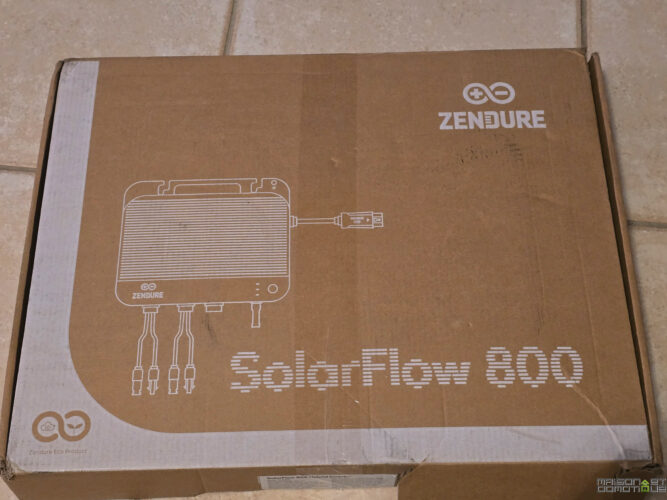
Inside, you'll find the SolarFlow 800, with its modern, compact design.
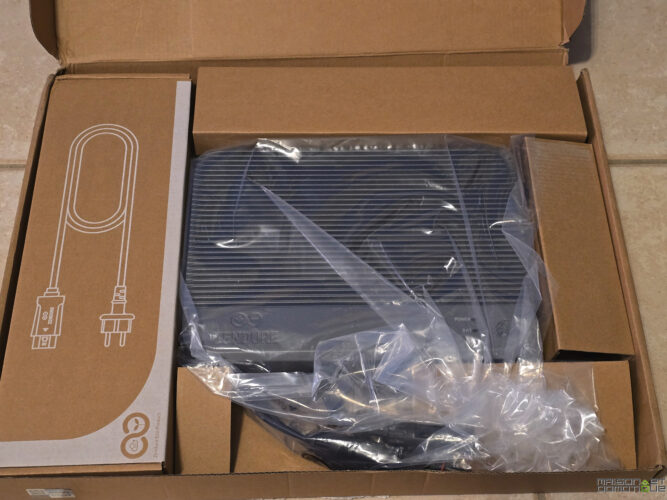
Included in the package are all the cables needed for installation, including a 70 cm cable for connection to the battery (a little short, but 3 and 5 meter versions are available as options). The system is compatible with the brand's AB1000 and AB2000 batteries, enabling storage capacity to be extended to 11520Wh with six AB2000 batteries. Impressive!
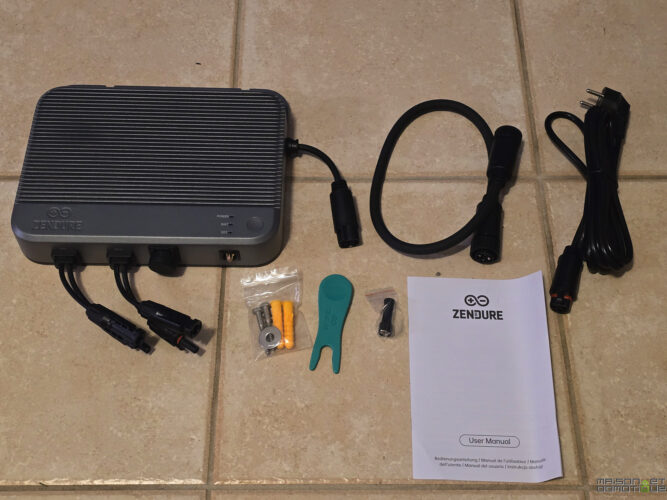
The main casing incorporates two MPPT inputs, each rated at 600W, enabling management of up to 1200W of solar panels.
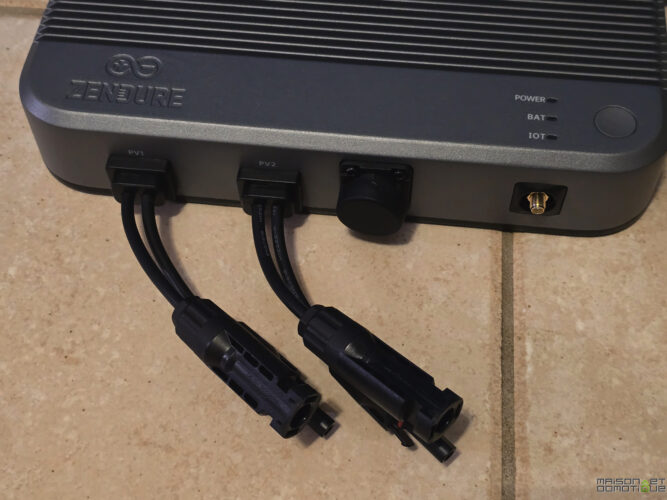
The MC4 connectors, classic in photovoltaics, are robust and clearly identified, making installation a breeze.
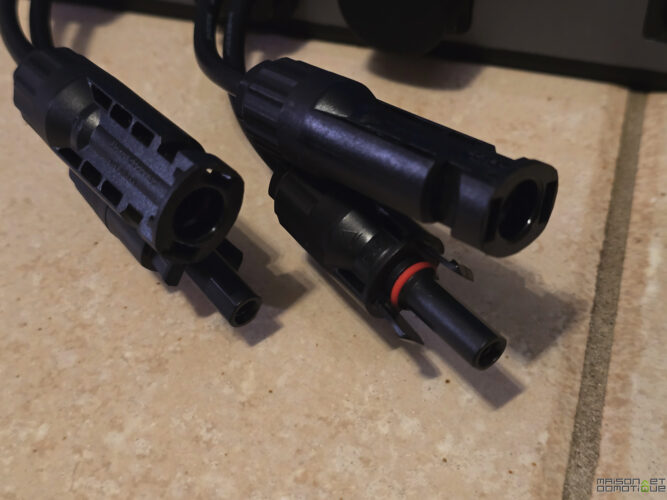
Despite all this, the SolarFlow 800 stands out for its compact dimensions: it's barely larger than a conventional microinverter, making it particularly discreet once installed.
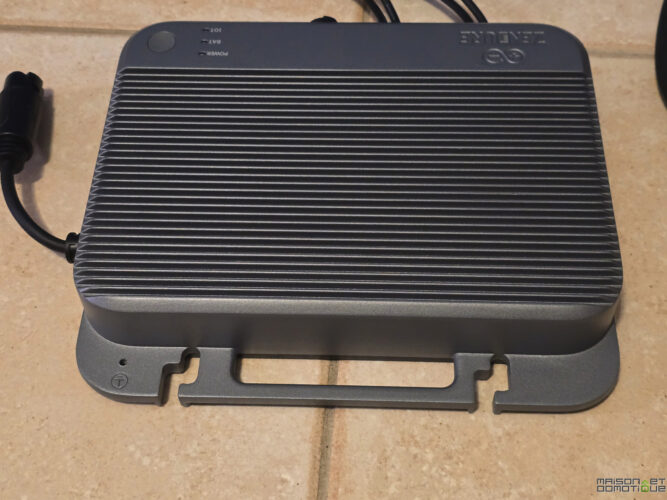
The finish is excellent, with an aluminum casing that inspires confidence and ensures good heat dissipation. IP67 certified, it can be installed outdoors without fear.
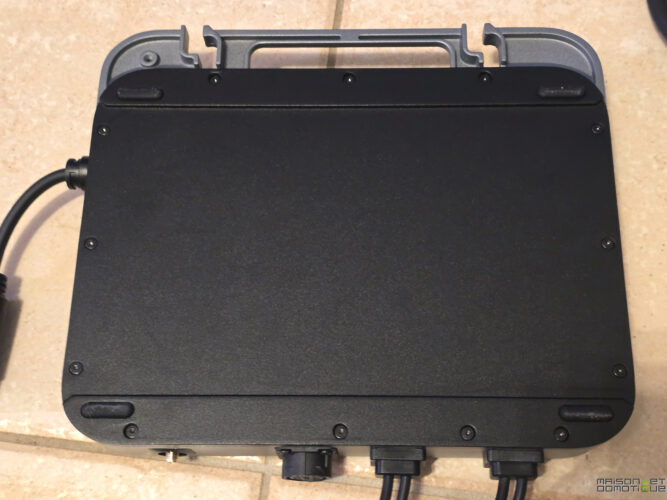
The display features simple but effective status LEDs, indicating battery level and operating status.

A multifunction button gives access to the main commands, such as Wi-Fi pairing or system start-up.
Installation made easy!
Installation of the Zendure SolarFlow 800 is remarkably simple and intuitive, even for the uninitiated. It all starts with the choice of location: the IP67-certified housing can be installed indoors or outdoors.
The system can be adapted to two main configurations. The first involves replacing an existing microinverter on a plug-and-play installation such as a solar balcony. Simply disconnect the old microinverter and connect the SolarFlow 800 in its place, using the standard MC4 connectors supplied. An important detail in passing: according to the manufacturer, the SolarFlow 800 starts producing energy at 14V, compared with 18V for conventional systems, thus capturing 10 to 20% more energy from morning to night, which is by no means negligible.
The second configuration allows the SolarFlow 800 to be added in parallel to an existing installation, without affecting the microinverters already in place. In this case, the system will automatically detect surplus energy using the Smart Meter (sold separately) and store it in the batteries.
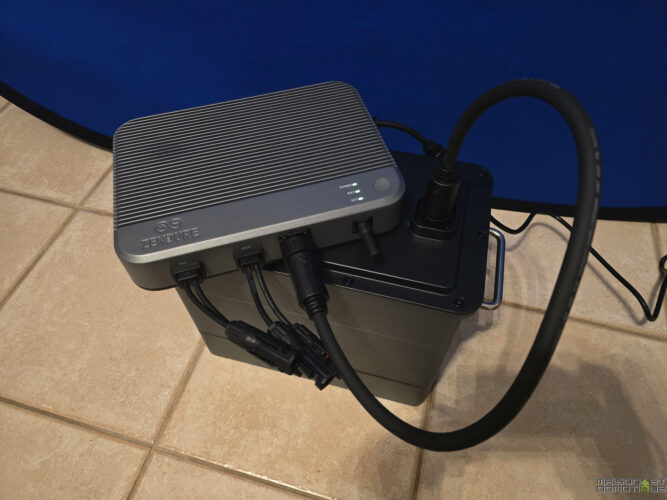
Electrical connection is particularly well thought-out: connectors are clearly identified and impossible to reverse.
Ideally, you'll need at least one of the brand's batteries for energy storage, be it an AB1000, AB2000 or AB2000s. If you already have batteries of this type, they're still perfectly compatible with the new Zendure SolarFlow 800. Here I have the new AB2000s, for example, which incorporates a heating system for outdoor use, and even a fire protection system.
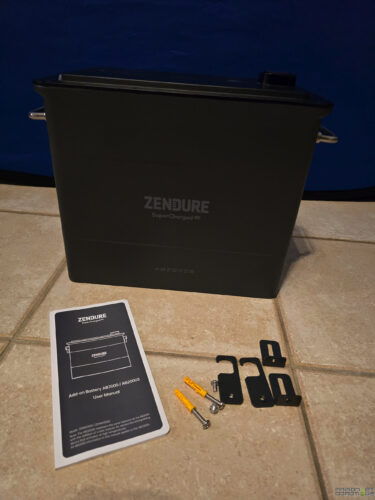
What I particularly like about these batteries is their ability to be easily stacked to increase storage capacity. The batteries have a connector at the top and at the bottom:
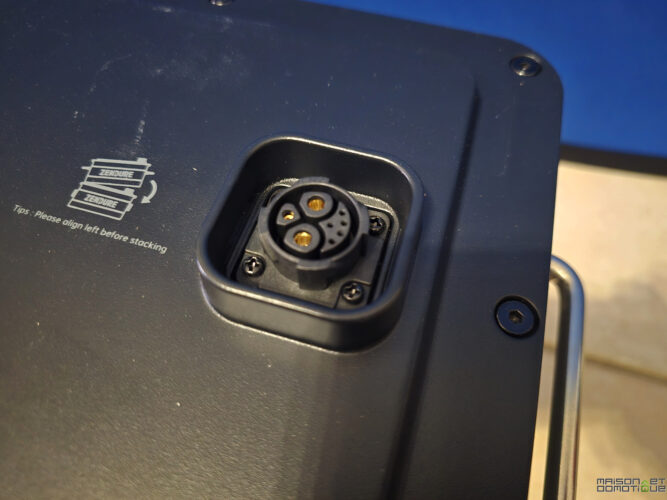

I had made a short video showing how easy it was to add batteries:
A crucial point to note: unlike some more complex solar installations, the SolarFlow 800 doesn't require the intervention of a professional electrician. It's a true plug-and-play system that simply connects to a standard electrical outlet. Commissioning is then carried out via the mobile app, which guides the user step by step through the initial configuration.
In my case, I opted for the Zendure SolarFlow 800 accompanied by an AB2000s battery (i.e. nearly 2000Wh) and two 430w rigid panels.
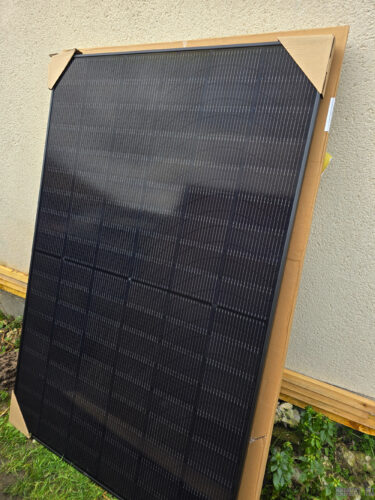
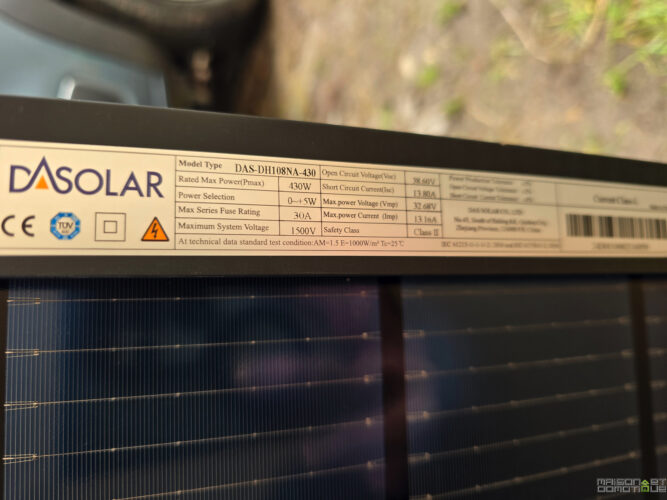
These panels were mounted on the roof of a garden shed, but they can also be placed on the ground like any other solar station, thanks to the brackets supplied.
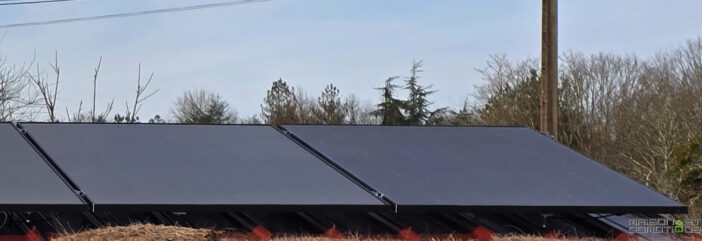
The microinverter is installed underneath, coupled to an AB2000s battery:
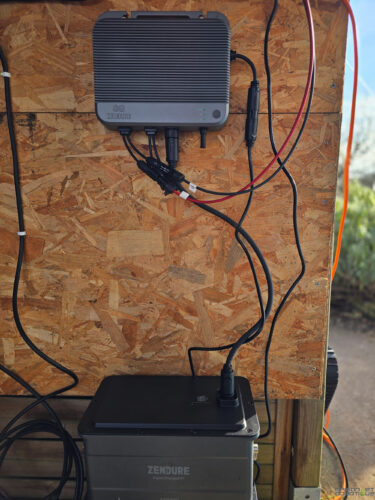
As already mentioned, installation is straightforward: connect the MC4 connectors of the solar panels to the inverter:
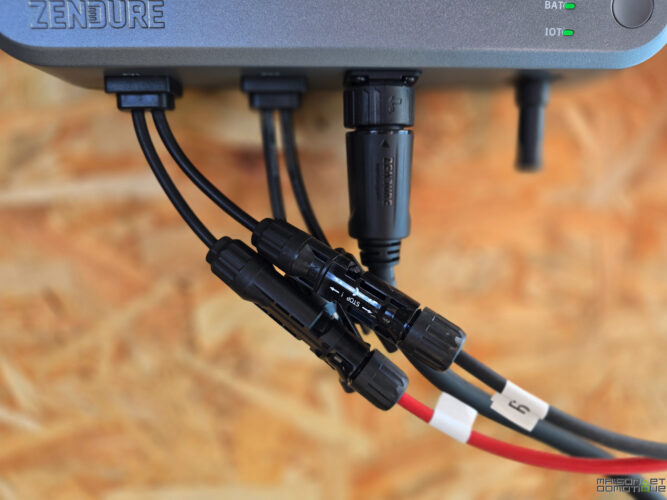
Then connect the inverter to the battery using the cable supplied:

Then plug the inverter into a standard household outlet.
Intelligent, intuitive operation
Day-to-day use of the SolarFlow 800 is child's play, thanks in no small part to its sophisticated mobile application. On opening the device, all you have to do is ask to add a device:
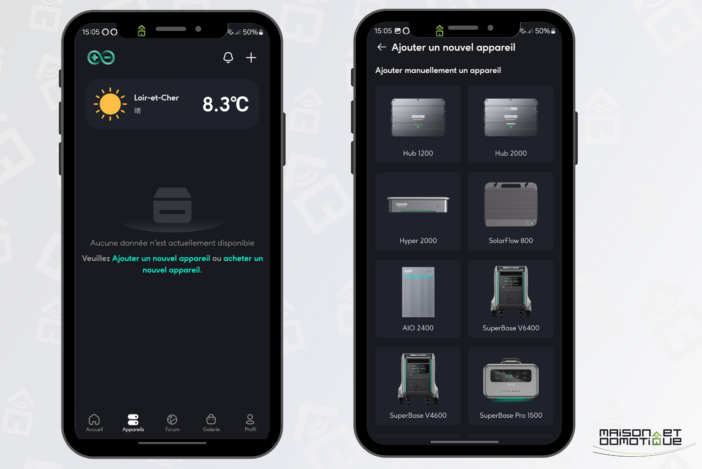
Then follow the instructions: press and hold the button on the Zendure SolarFlow 800 for pairing.
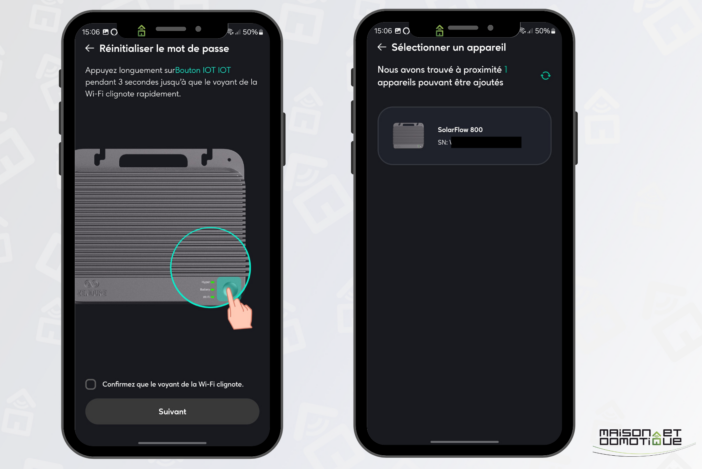
Then proceed with the Wifi connection.
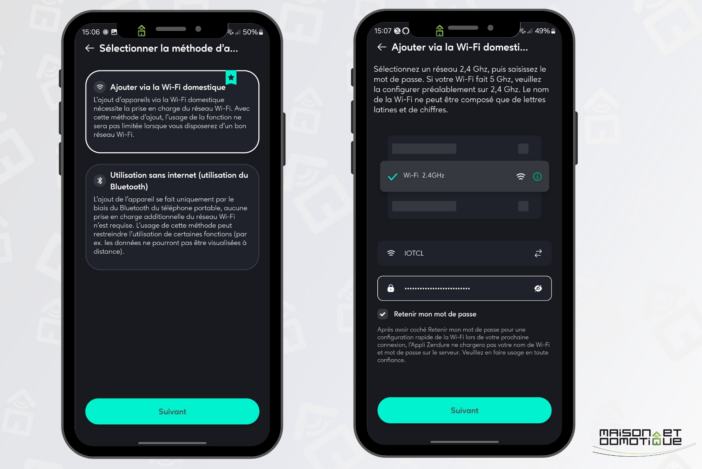
The new application now offers a global approach to energy management, centered around the concept of “home”. Gone are the days of juggling different devices! Everything is controlled from a unified dashboard that displays solar production, electricity consumption and battery status in real time. The user is invited to create this global view and the devices to be integrated into it:
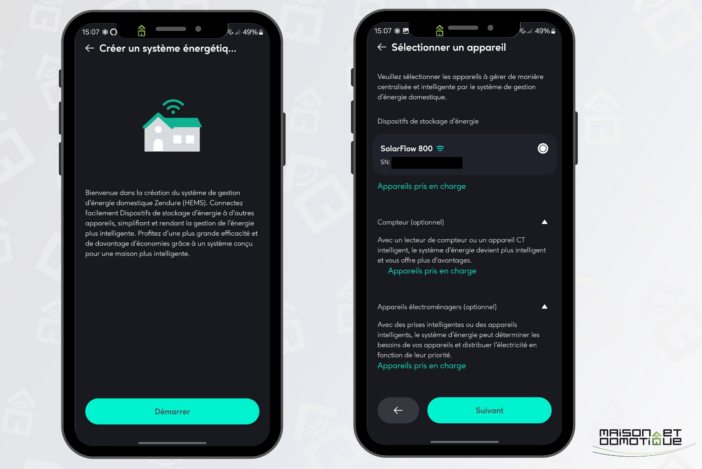
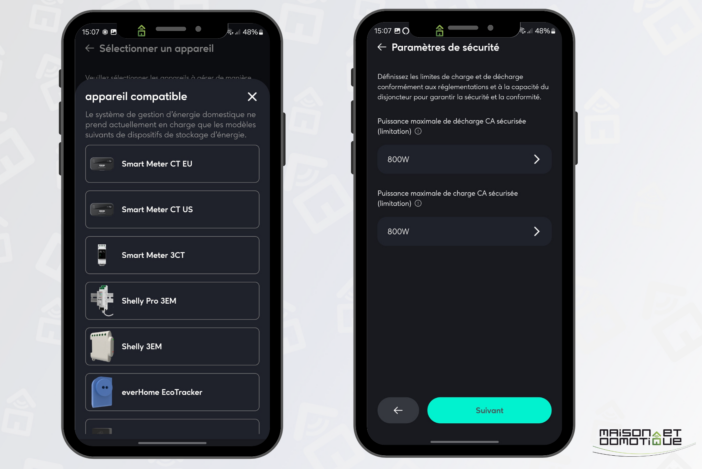
Although the system can apparently output more than 800w, a disclaimer has to be validated:
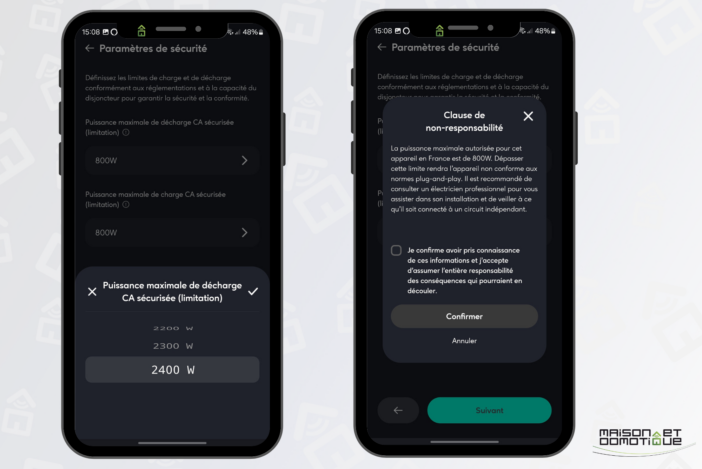
Do so at your own risk, depending on your electrical installation!
Configuration is then particularly flexible. For example, you can define time slots to optimize the use of your system: charging the batteries during off-peak hours (midnight to 6 a.m.) and discharging them during peak hours (6 a.m. to 10 p.m.). In fact, this microinverter allows you to charge the battery from the mains if required!
The system automatically adjusts power output in less than three seconds, an impressive level of responsiveness that optimizes self-consumption.
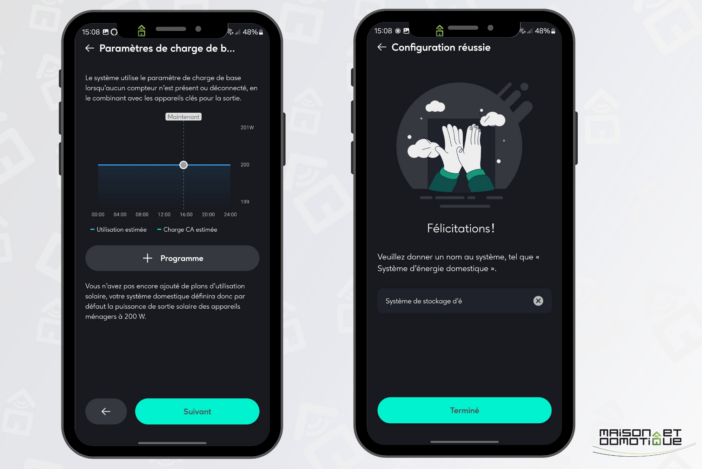
The application also lets you fine-tune battery protection, with a minimum charge threshold set at 10% to preserve battery life.

Data visualization is particularly sophisticated, with detailed graphs showing production, consumption and storage history.
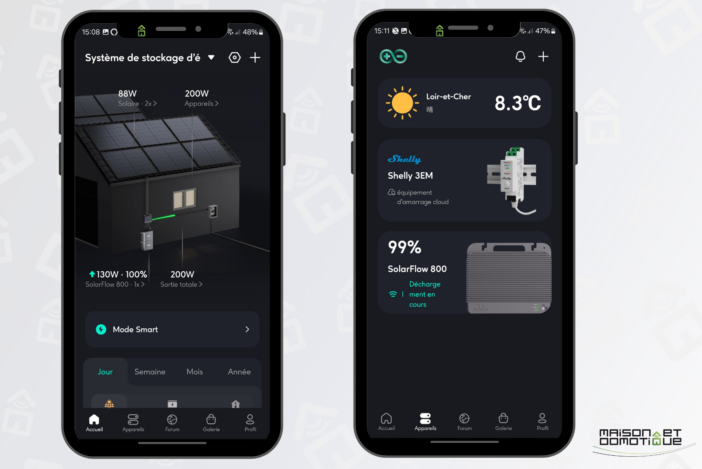
A particular strength of the system is its ability to operate locally, without relying on an Internet connection. This major advance on previous versions guarantees optimum system stability. The configuration also makes it possible to prevent surplus energy being sent back to the grid if you don't have a resale contract.
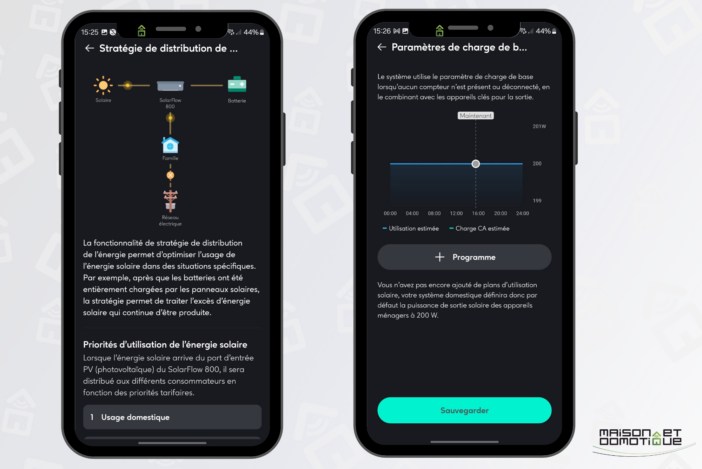
Even more interestingly, the system can be coupled with global consumption sensors, such as the Shelly Pro 3EM we've already seen on other installations, or connected sockets for even more precise monitoring of consumption by appliance.
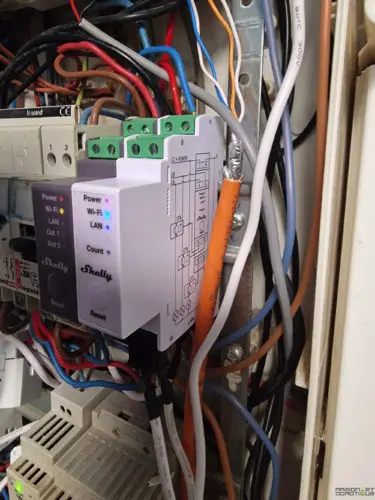
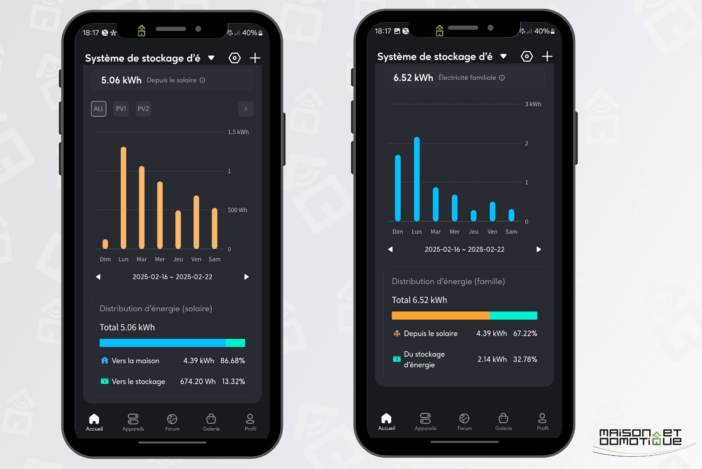
Return on experience and profitability: sobering figures
Let's talk cash: with an entry price of €299 for the SolarFlow 800 alone, we're faced with a particularly aggressive offer on the market, especially when compared with standard microinverters, which don't have all this intelligence and the ability to store on a battery.
SolarFlow 800
But the manufacturer also offers kits, such as the one including two 430W bifacial panels and the SolarFlow 800 at €479, which represents excellent value for money compared to competing offers. To put things in perspective, just 2-3 years ago, a 300-400W plug-and-play solar kit easily cost 600-700€.
The question of profitability needs to be approached from several angles:
In pure battery mode (off-peak charging/peak discharging), the return on investment is longer, especially in France where we still benefit from relatively inexpensive electricity, despite successive increases in recent years. However, a major upgrade of the HEMS system is scheduled for March 2025, enabling automatic management according to dynamic electricity prices, notably with EDF's Tempo offer. That's going to make life a whole lot easier when it comes to managing red days!
If you have other photovoltaic installations, the system is also capable of detecting surplus production, recovering it and storing it on its battery, as the Hyper 2000 already offered.

Coupled with solar panels, however, the system becomes much more interesting. The steady rise in electricity prices is accelerating profitability: on a conventional solar installation, the return on investment has dropped from 8 years to 3 – 4 years.
As far as durability is concerned, the batteries we use offer excellent longevity, with 3,000 to 4,000 cycles before starting to lose efficiency. This is no mean feat when you consider that some conventional lithium batteries show signs of weakness as early as 600-800 cycles.

The system also features an intelligent protection system that always maintains a minimum of 10% charge in the battery, guaranteeing its long life. In winter, an integrated heating system maintains performance even in cold weather. We've already tested a number of Zendure solutions over the past two years, and the manufacturer has evolved its system considerably, making it one of the best solutions on the market.
Face to face with the Hyper 2000: two different philosophies
We tested the Zendure Hyper 2000 a few months ago, and it was a really top-notch solution. At first glance, we wondered what the SolarFlow 800 had to offer. In fact, the two are complementary products rather than competitors. Here are the main differences:
Power output is the first point of distinction: where the Hyper 2000 delivers up to 1200W, the SolarFlow 800 makes do with, as its name suggests, 800W. This difference is important for large-scale energy consumers, but for a typical domestic installation, 800W is generally sufficient.
In terms of storage capacity, both systems accept AB1000 and AB2000 batteries, up to six batteries (via a recent Hyper 2000 upgrade), giving an impressive maximum capacity of 11,520Wh with AB2000s.
The most striking difference is the price: at €299, the SolarFlow 800 is a particularly attractive entry-level solution, around half the price of the Hyper 2000.
Another major distinction lies in its networking capability: the Hyper 2000 can be coupled with other units via the Zendlink system, enabling the creation of more powerful installations. The SolarFlow 800, on the other hand, remains a stand-alone unit, perfect for more modest installations.
Energy efficiency is comparable between the two systems, with an excellent 96%. Both devices also benefit from the latest software developments, including local management without dependence on the cloud, a major improvement on previous versions.
The final word: an affordable revolution in solar storage
The Zendure SolarFlow 800 undeniably marks a turning point in the world of solar energy storage. With its particularly aggressive price of €299 and exceptional efficiency of 96%, it democratizes access to solar self-consumption.
The complete kit including two 430W bifacial panels for 479€ represents a particularly attractive offer, when you consider that just two years ago, a 300-400W plug-and-play solar kit easily cost twice as much. The ability to expand the system with up to six AB2000 batteries, offering a maximum capacity of 11,520Wh, makes it a scalable solution for every need.
The completely redesigned application, now running locally without dependence on the cloud, and the ease of installation are major assets that should appeal to novices and experienced users alike.
If you're looking to embark on your solar adventure or optimize an existing installation, the SolarFlow 800 is well worth a look. It combines performance, simplicity and an attractive price, all in a well-thought-out package that should set a trend in the solar energy storage market.

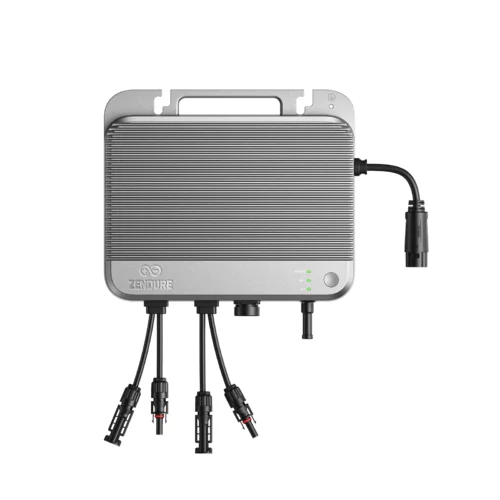
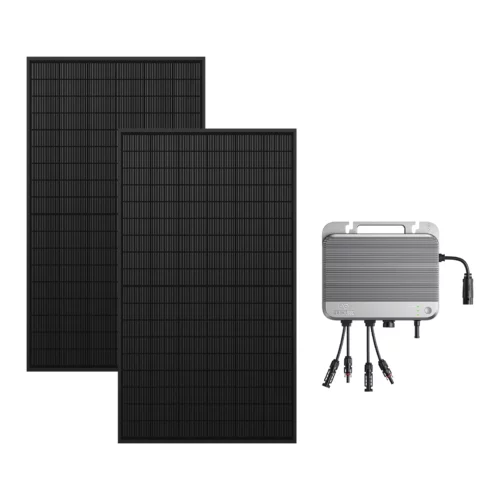
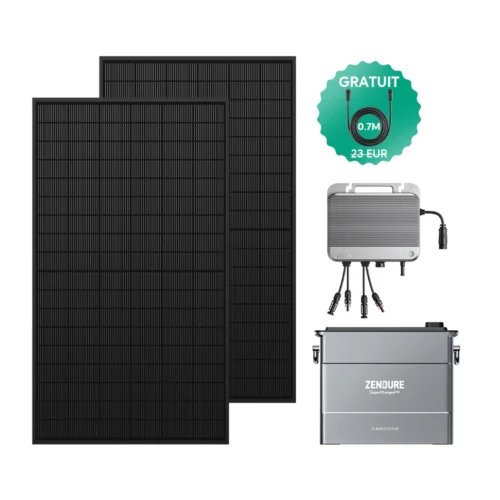
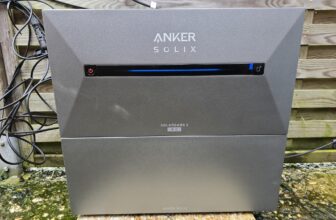
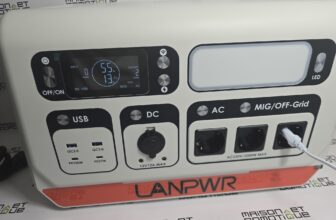
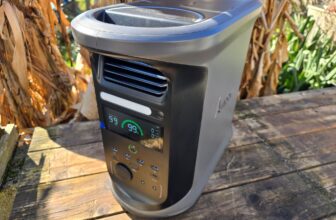
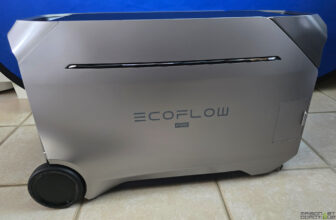

Please remain courteous: a hello and a thank you cost nothing! We're here to exchange ideas in a constructive way. Trolls will be deleted.